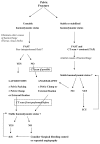Clinical review: initial management of blunt pelvic trauma patients with haemodynamic instability
- PMID: 17300738
- PMCID: PMC2151899
- DOI: 10.1186/cc5157
Clinical review: initial management of blunt pelvic trauma patients with haemodynamic instability
Abstract
Pelvic trauma can lead to severe, uncontrollable haemorrhage and death related to prolonged shock and multiple organ failure. Massive retroperitoneal haematoma should be assumed to be present in cases of post-traumatic haemodynamic instability associated with pelvic fracture in the absence of extrapelvic haemorrhagic lesions. This review describes the pathophysiology of retroperitoneal haematoma in trauma patient with blunt pelvic fracture, considering the roles of venous and arterial bleeding. Efficacy and safety of haemostatic procedures are also discussed, and particular attention is given to the efficacy of pelvic angiographic embolization and external pelvic fixation. A decision making algorithm is proposed for the treatment of trauma patients with pelvic fracture that takes haemodynamic status and associated lesions into account.
Figures


Similar articles
-
Blunt abdominal trauma and severe pelvic rupture. What to do?Acta Chir Belg. 1997 Apr;97(2):65-8. Acta Chir Belg. 1997. PMID: 9161586 Review.
-
Angiographic embolization for pelvic fractures in older patients.Arch Surg. 2004 Jul;139(7):728-32; discussion 732-3. doi: 10.1001/archsurg.139.7.728. Arch Surg. 2004. PMID: 15249404
-
External fixation or arteriogram in bleeding pelvic fracture: initial therapy guided by markers of arterial hemorrhage.J Trauma. 2003 Mar;54(3):437-43. doi: 10.1097/01.TA.0000053397.33827.DD. J Trauma. 2003. PMID: 12634521
-
Review of the pathophysiology and acute management of haemorrhage in pelvic fracture.Injury. 2006 Jul;37(7):602-13. doi: 10.1016/j.injury.2005.09.007. Epub 2005 Nov 23. Injury. 2006. PMID: 16309680 Review.
-
Arterial embolization for pelvic fractures after blunt trauma: are we all talk?Am J Surg. 2010 Dec;200(6):752-7; discussion 757-8. doi: 10.1016/j.amjsurg.2010.06.006. Am J Surg. 2010. PMID: 21146016
Cited by
-
Management of bleeding following major trauma: an updated European guideline.Crit Care. 2010;14(2):R52. doi: 10.1186/cc8943. Epub 2010 Apr 6. Crit Care. 2010. PMID: 20370902 Free PMC article.
-
Epidemiologic, Postmortem Computed Tomography-Morphologic and Biomechanical Analysis of the Effects of Non-Invasive External Pelvic Stabilizers in Genuine Unstable Pelvic Injuries.J Clin Med. 2021 Sep 24;10(19):4348. doi: 10.3390/jcm10194348. J Clin Med. 2021. PMID: 34640366 Free PMC article.
-
Proposal of standardization of every step of angiographic procedure in bleeding patients from pelvic trauma.Eur J Med Res. 2021 Oct 14;26(1):123. doi: 10.1186/s40001-021-00594-8. Eur J Med Res. 2021. PMID: 34649598 Free PMC article. Review.
-
Comparison between laparotomy first versus angiographic embolization first in patients with pelvic fracture and hemoperitoneum: a nationwide observational study from the Japan Trauma Data Bank.Scand J Trauma Resusc Emerg Med. 2013 Dec 3;21:82. doi: 10.1186/1757-7241-21-82. Scand J Trauma Resusc Emerg Med. 2013. PMID: 24299060 Free PMC article.
-
Integrating eFAST in the initial management of stable trauma patients: the end of plain film radiography.Ann Intensive Care. 2016 Dec;6(1):62. doi: 10.1186/s13613-016-0166-0. Epub 2016 Jul 11. Ann Intensive Care. 2016. PMID: 27401440 Free PMC article.
References
-
- Dalal SA, Burgess AR, Siegel JH, Young JW, Brumback RJ, Poka A, Dunham CM, Gens D, Bathon H. Pelvic fracture in multiple trauma: classification by mechanism is key to pattern of organ injury, resuscitative requirements, and outcome. J Trauma. 1989;29:981–1000. - PubMed
-
- Rothenberger DA, Fischer RP, Strate RG, Velasco R, Perry JF., Jr The mortality associated with pelvic fractures. Surgery. 1978;84:356–361. - PubMed
-
- Smejkal R, Izant T, Born C, Delong W, Schwab W, Ross SE. Pelvic crush injuries with occlusion of the iliac artery. J Trauma. 1988;28:1479–1482. - PubMed
-
- Mucha P, Jr, Welch TJ. Hemorrhage in major pelvic fractures. Surg Clin North Am. 1988;68:757–773. - PubMed
Publication types
MeSH terms
LinkOut - more resources
Full Text Sources
Medical

